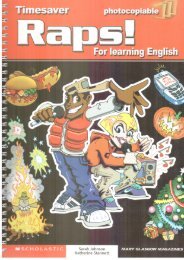English_Book_2-Teacher_300913
English_Book_2-Teacher_300913
English_Book_2-Teacher_300913
Create successful ePaper yourself
Turn your PDF publications into a flip-book with our unique Google optimized e-Paper software.
5TEACHER’S NOTESPutting it togetherAt the amusement park (15 min.)Background notesAmusement parks are large, commercial parks withattractions, such as roller coasters, that are designed togive riders a thrill. Well-known amusement parks in theUnited States are Disneyland in California and DisneyWorld in Florida. There are many amusement parks inFlorida, including Universal Studios and SeaWorld.Driver’s licenses in the United States are issued by eachstate, and the age at which a teen can obtain one varies.Though a few states permit students to start learning todrive at age fourteen, most allow students to start at agefifteen and get their license at age sixteen.• You may also want to have students practice thedialogue. Work on students’ pronunciation as youplay the audio or read the dialogue aloud. Thenassign groups of four and have students practice,changing roles after each reading so that allstudents read each role once. If time allows, havestudents practice the dialogue again, substitutingtheir own names. Then call on one or more groupsto perform for the class. For further extensionideas, see the Dialogues and Comprehension notesin the Introduction, page xii.ActivitiesFun with songs 1, page 62Focus on culture 1, pages 64–65A.• Read the title and instructions aloud. Elicit whatstudents know about amusement parks. Thenhave students look at the photos. Help studentspredict by asking questions such as Who do youknow in the first picture? (Joey, Brian, Andy, andLiza) Where are they? (at home) Does Liza lookhappy? (no) Where are they on Sunday afternoon?(at an amusement park) What is Brian looking at inpicture 4? (his watch; the time)• Have students work individually to read thedialogue and fill in the blanks. Then elicitstudents’ guesses.B.• 20 Play the audio and have students check theiranswers. Pause after each of the answers is spokenand elicit it from the class. Ask students to raisetheir hands if they got the correct answer.Answer key1. No, I can’t2. No, you can’t3. Sure• To extend work with the photostory, go overvocabulary such as I can’t wait, I’ll be right back,quick, closed, and instead.✎ Have students complete the Unit 1 test, page 80.T13Postcards_splitB_TE1_U01.indd T132/27/07 10:23:44 AM006-013_




